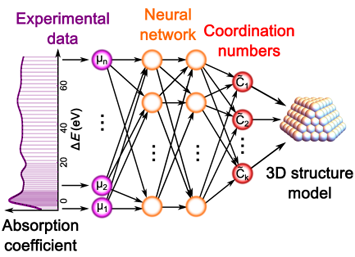- Home
-
Research Groups
Division Groups
- Artificial Photosynthesis
- Catalysis: Reactivity & Structure
- Electrochemical Energy Storage
- Electron- and Photo-Induced Processes for Molecular Energy Conversion
- Neutrino and Nuclear Chemistry
- Surface Electrochemistry and Electrocatalysis
Associated Groups
- Catalysis for Alternative Fuels Production
- Nanostructured Interfaces for Catalysis
- Structure and Dynamics of Applied Nanomaterials
- People
- Operations
- News
- Events

Structure and Dynamics of Applied Nanomaterials
Supervised Machine Learning Methods for XANES data modeling in nanoparticles
 Tracking the structure of heterogeneous catalysts under operando conditions remains a challenge due to the paucity of experimental techniques that can provide atomic-level information for catalytic metal species. Here we report on the use of X-ray absorption near edge structure (XANES) spectroscopy and supervised machine learning (SML) for refining the three-dimensional geometry of metal catalysts. SML is used to unravel the hidden relationship between the XANES features and catalyst geometry. To train our SML method, we rely on ab-initio XANES simulations. Our approach allows one to solve the structure of a metal catalyst from its experimental XANES, as demonstrated here by reconstructing the average size, shape and morphology of well-defined platinum nanoparticles. This method is applicable to the determination of the mono- and bimetallic nanoparticle structure in operando studies and can be generalized to other nanoscale systems. It also allows on-the-fly XANES analysis, and is a promising approach for high-throughput and time-dependent studies.
Tracking the structure of heterogeneous catalysts under operando conditions remains a challenge due to the paucity of experimental techniques that can provide atomic-level information for catalytic metal species. Here we report on the use of X-ray absorption near edge structure (XANES) spectroscopy and supervised machine learning (SML) for refining the three-dimensional geometry of metal catalysts. SML is used to unravel the hidden relationship between the XANES features and catalyst geometry. To train our SML method, we rely on ab-initio XANES simulations. Our approach allows one to solve the structure of a metal catalyst from its experimental XANES, as demonstrated here by reconstructing the average size, shape and morphology of well-defined platinum nanoparticles. This method is applicable to the determination of the mono- and bimetallic nanoparticle structure in operando studies and can be generalized to other nanoscale systems. It also allows on-the-fly XANES analysis, and is a promising approach for high-throughput and time-dependent studies.
J. Timoshenko, D. Lu, Y. Lin, A. I. Frenkel
Supervised machine learning-based determination of three-dimensional structure of metallic nanoparticles J. Phys. Chem. Lett., 2017, DOI: 10.1021/acs.jpclett.7b02364




